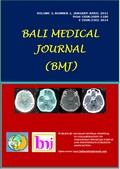GROUP-B STREPTOCOCCUS IN PREGNANT WOMEN: Prevalence of Colonization and Sensitivity Pattern in Denpasar during June 2007?May 2008
Abstract
Objective: Group-B Streptococci (GBS) are Gram-positive cocci that are the most common cause of early onset neonatal sepsis. The mortality rate of early onset neonatal sepsis has been reported up to 50%. One of the major risks of early onset neonatal sepsis is GBS colonization in birth canal of pregnant women that can infect the baby during process of vaginal delivery. Antibiotic chemoprophylaxis for pregnant women that is colonized by GBS can reduce the risk of early onset neonatal sepsis. The detection of GBS colonization needs Todd Hewitt (TH) enrichment medium to reduce false negative result. Until now, there is no report about either prevalence of colonization or sensitivity pattern of Group B Streptococcus among pregnant women in Denpasar. The aims of this research were to determine the prevalence of GBS colonization and sensitivity pattern of GBS among pregnant women with Todd Hewitt enrichment medium. Method: This research was a descriptive cross-sectional study. Vaginal swab specimens from 35-37 weeks gestation pregnant women were collected and 32 samples that met the inclusion criteria were cultured on Blood agar (BA) plates, Chromagar (CA) plates, and Todd Hewitt (TH) broth. The GBS colonization that grew in culture medium was followed by antibiotic sensitivity test. Results: In the present study, we found that the prevalence of GBS colonization in pregnant women detected with culture method using BA and CA without TH broth was 9.4%, whereas the prevalence with culture method using BA and CA enriched by TH broth was 31.3%. Moreover, GBS showed resistance to penicillin, erythromycin, and cefazolin. It is indicated that TH enrichment medium seems to be promising as a screening method for GBS colonization in pregnant women in Bali. Conclusion: There was an enrichment detection of GBS prevalence colonization in pregnant women detected the swab with culture method using BA and CA enriched by TH compare to BA and CA without TH broth. Moreover, GBS showed resistance to penicillin, erythromycin, and cefazolin. It is indicated that TH enrichment medium seems to be promising as a screening method for GBS colonization in pregnant women in Bali.


